The bagworms are out in full force this year across North Texas. I haven’t seen them this bad in a while, and I am guessing the mild winter didn’t help the problem. Bagworms seem to sneak up on homeowners quickly since they don’t really stand out until the leaves on their pouches turn brown.
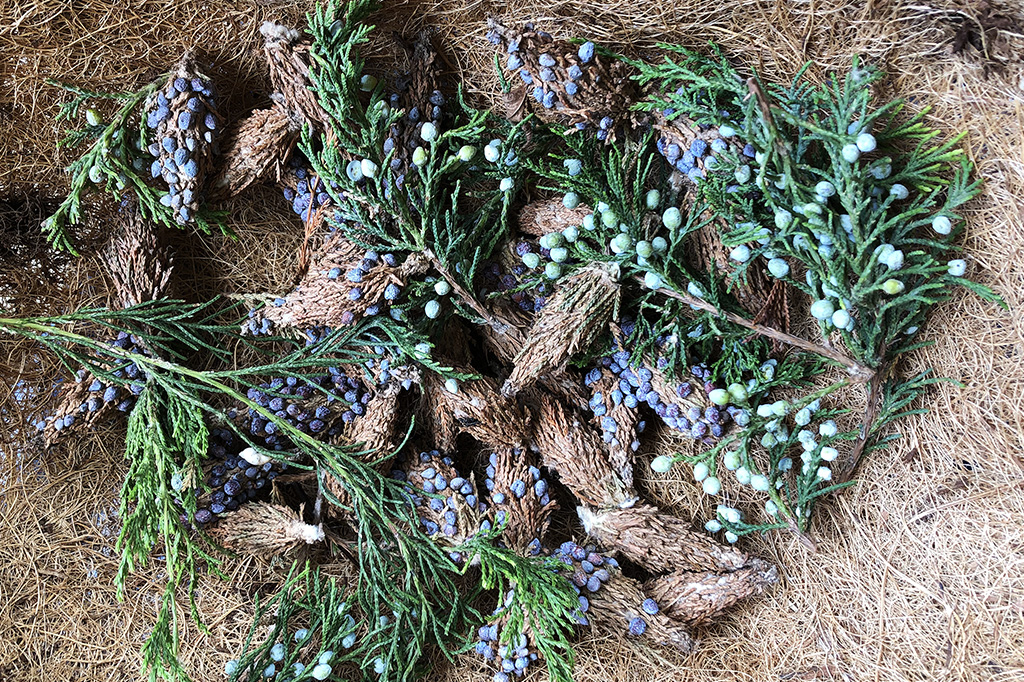
Bagworms prefer plants and trees with smaller and more narrow leaves, but will make due with other tree types if needed. Shrubs and flowers are not off limits either.
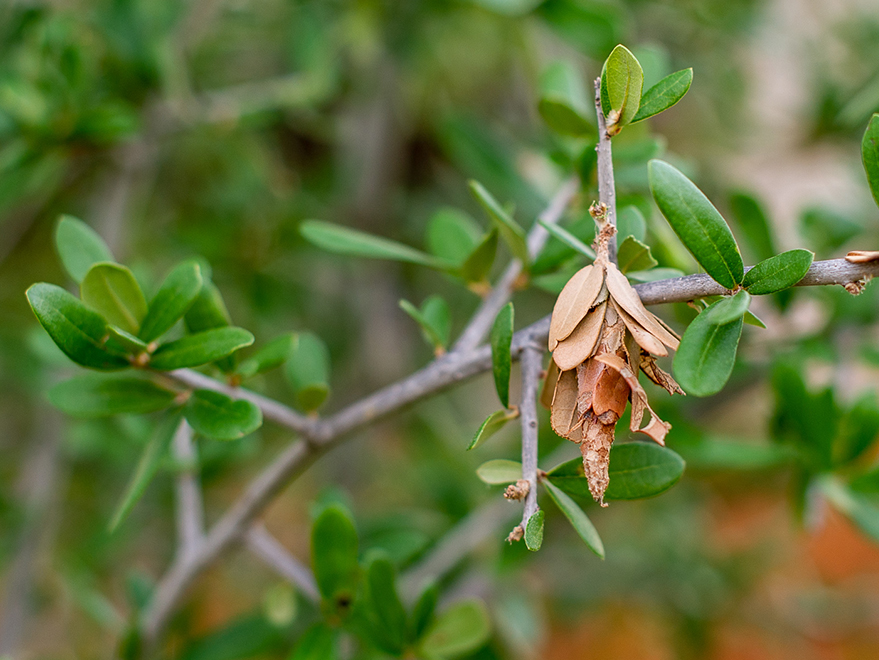
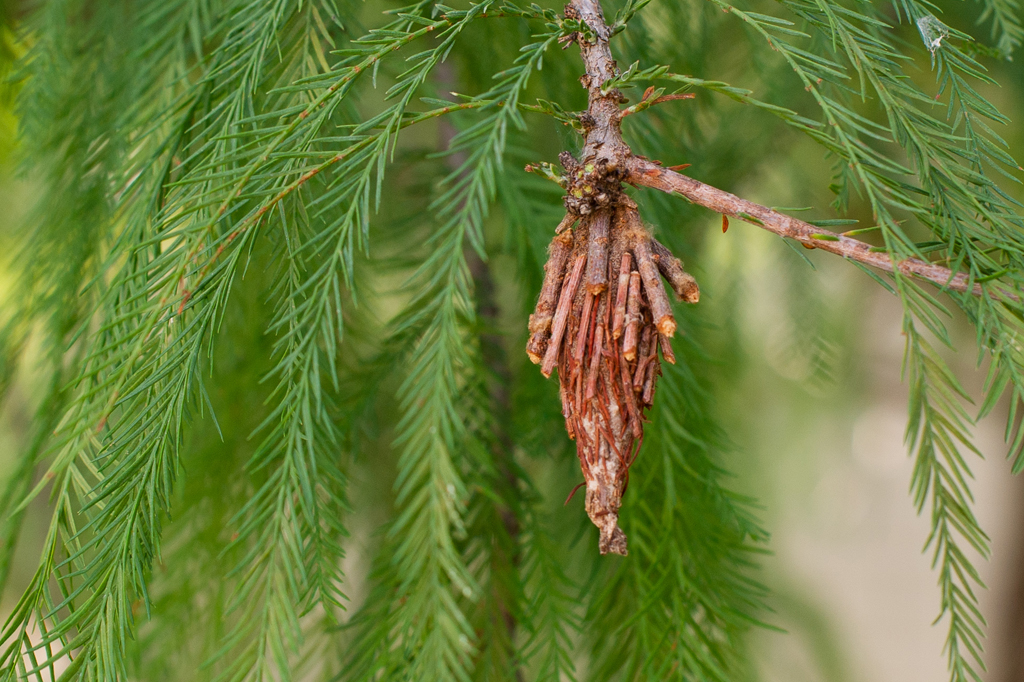
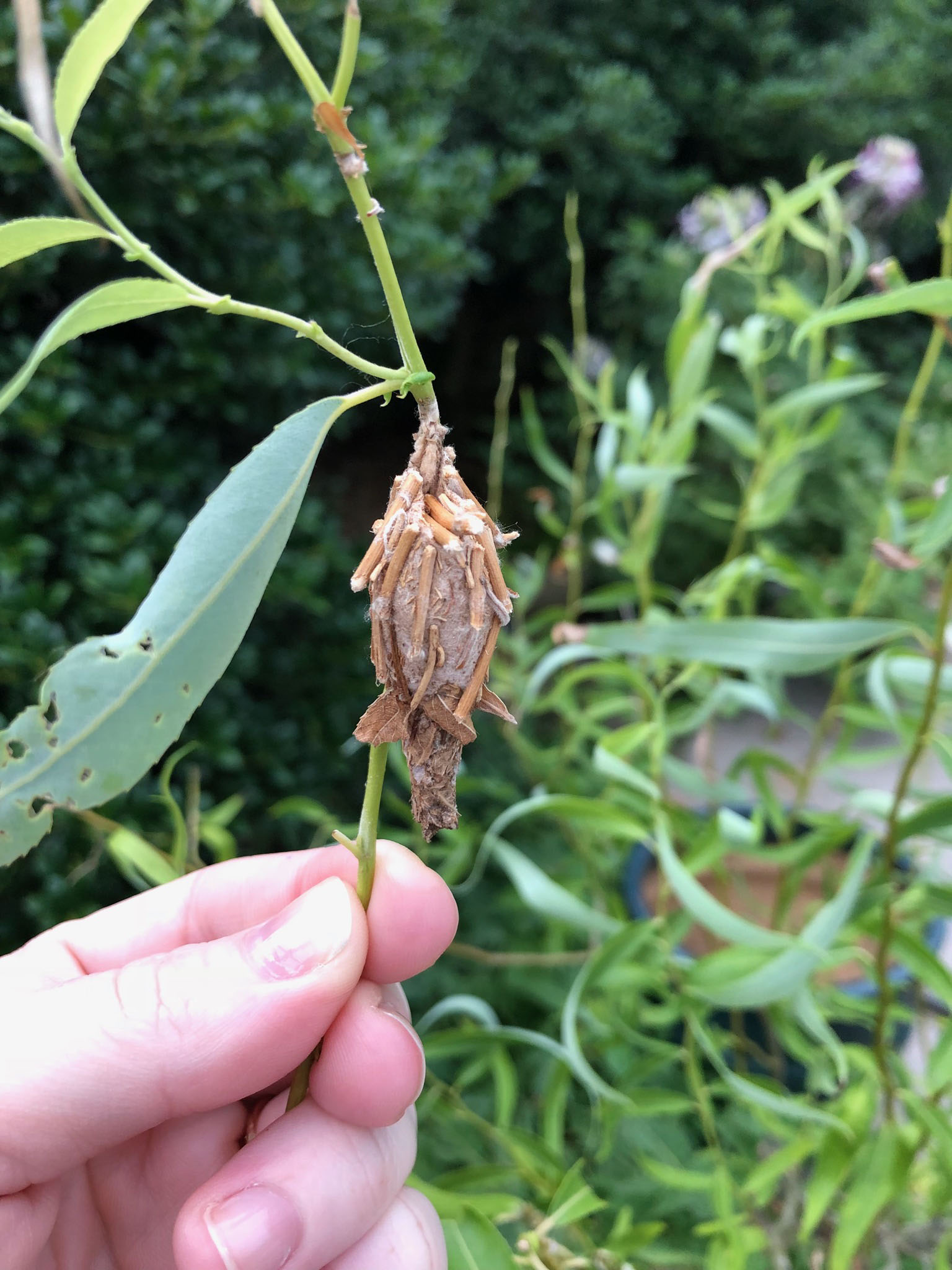
The Bagworm Life Cycle
- The eggs of Bagworms hatch out of the parent’s pouch throughout the end of Spring and beginning of Summer. They repel down a string and the wind catches them, moving them to a new location.
- After the larva finds a host, it starts to make it’s protective pouch. The larva stays inside the pouch, only sticking its head out enough to eat.
- The bagworm larvae continues eating until the end of Summer. Once done eating, then it moves to a branch and permanently attaches to it until it turns into a pupa.
- The adults don’t appear until early Fall. The males are small with transparent wings, and the females are wingless. The females also do not leave their pouch. After maturing and mating, the adult males and females die immediately after.
How do I treat bagworms?
The good news is that not all bagworm treatments need chemicals. See the example scenarios below and my treatment recommendations for each.
1. I have only a few bagworms on my tree.
This is great news, and you can contain this pest without harming all of the beneficial insects in your yard. Simply pull the pouches off and destroy them. No chemicals are recommended for a small amount of bagworms and pouches on your plants. I myself place them into a bag and then quickly smash them. I hate killing insects, but obvious these could do substantial harm to your plants if not contained on some level. I always recommend organic control first.
2. I see lots of bagworms on my tree, but only see them on one or two trees.
I also am going to recommend that you go the organic route and simply just pull the pouches off. Since it’s a small quantity of trees that you have, you can have these pouches pulled off in no time without harming all of the other beneficial insects in your yard. Please simply pull them off and destroy them without using any chemicals. You can either burn them or smash them.
3. I have bagworms all over my trees and I have lots trees with them.
With a large amount of trees it’s not likely realistic to recommend treatment by manually pulling them off. While I hate to recommend pesticides, I don’t think you will have the time. However, if you are up for the organic option, please see my tips above. If not, please continue reading.
For chemical treatment, it’s important to first check the bagworms to see if they are still eating. We recommend Triazicide and you have to apply it before they totally seal up in their pouch, or they will not even ingest the chemical. The chemical is only ingested while they are still eating. See the below picture for an example of what to expect when you see them eating. Their head barely pokes out of the pouch in most cases. Do not waste time or money treating them if they are no longer eating. Please follow the instructions on the bottle when applying.
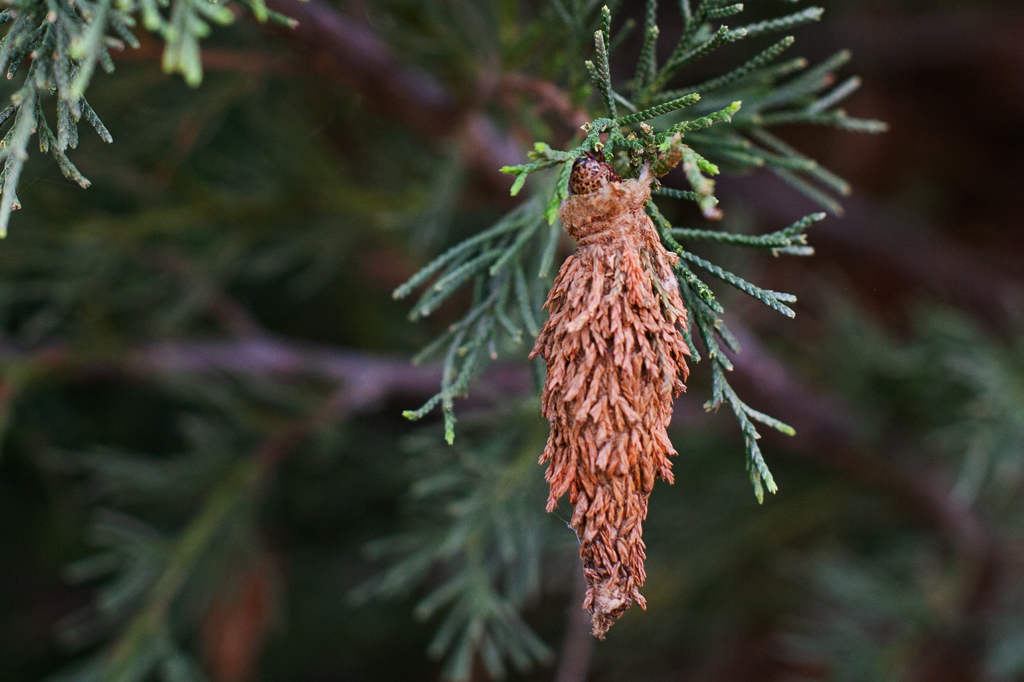
4. I have bagworms on a lot of trees, but they have already stopped eating.
Chemical treatment will not work on your bagworms right now since they are no longer eating and therefore do not have a chance to ingest the chemical. You can wait until next Spring/Summer to treat, or you can manually remove the pouches to help reduce the potential damage to your trees next year.
I hope you have found this blog helpful. Have other pests in the garden giving you a headache? Write in and share your struggle so we can help advise you on how to treat.
-Denise














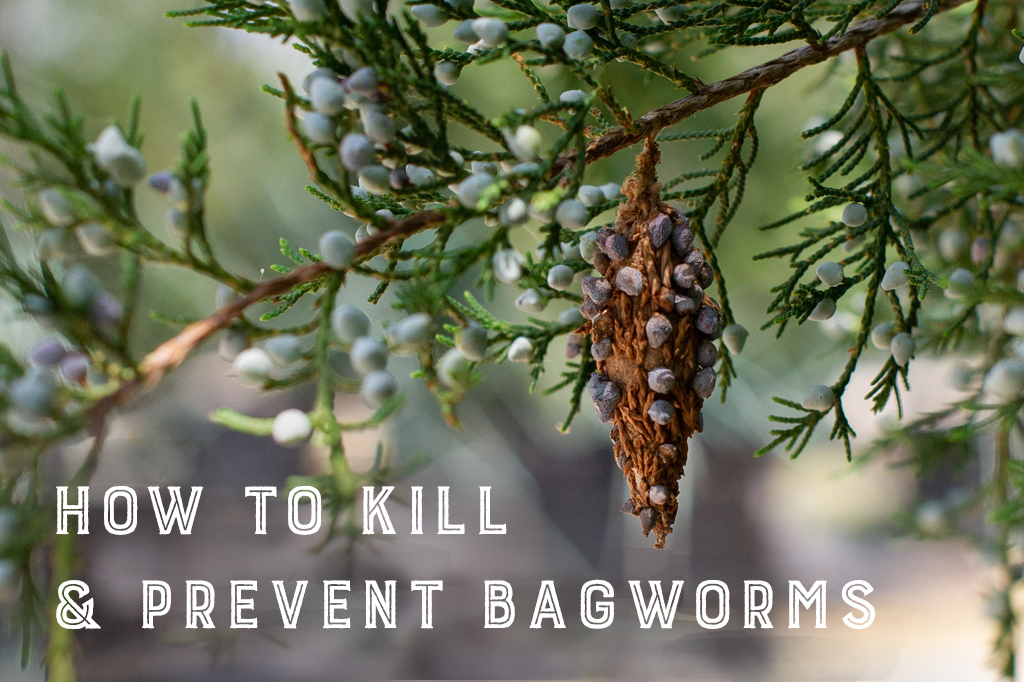
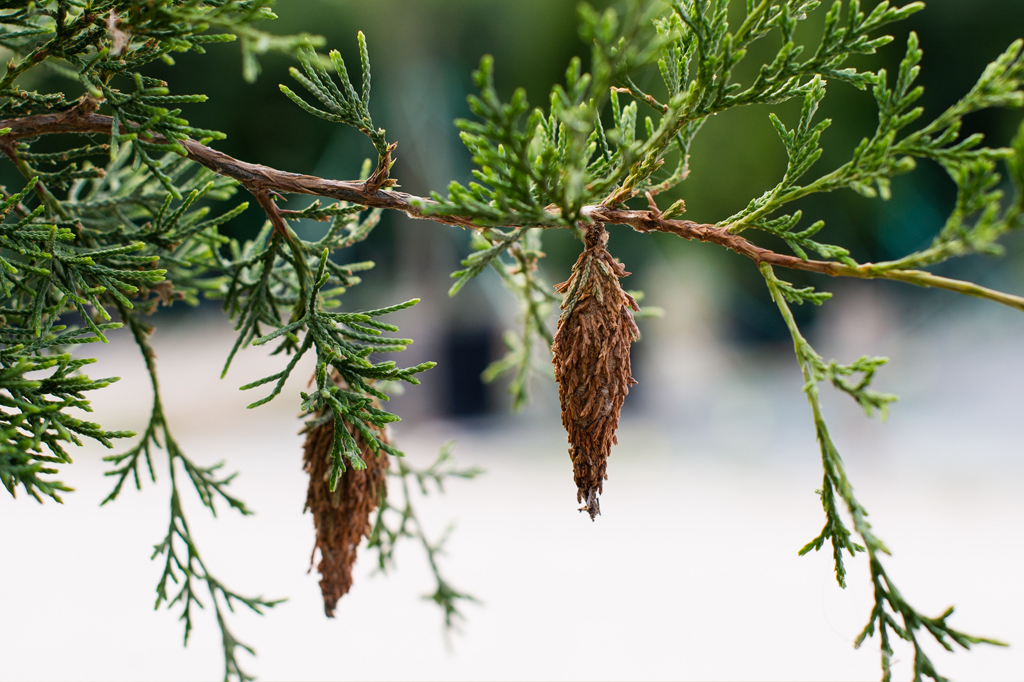
My Thuja ‘Green Giant’ hedgerow was infested, so I used Bacillus thuringiensis (BT) with some success. It’s a bacteria that only affects chewing insects, especially caterpillars. They lose their appetite, quit eating, and fade away. It might have to be sprayed 2-3 weeks in a row (a week apart), and it’s recommended to treat just as soon as you see activity.
Thanks for your comment Kelly. I have heard of those and other biological pesticides, it’s all very fascinating to read about. So many products on the market these days, but if you are having great success with this then I would definitely stay with it. Hopefully after a few years the bagworm numbers go down in your yard. Another tip for keeping healthy insect populations is to only treat if needed, don’t just treat in case like many “arborists” and so called experts try to get people to do for easy money. -Denise
Can wasp spray kill bagworms after limbs are remove from the tree and the bag is cut into??
Hi Betty, I have not heard of that but this is a good time of year to spray for bagworms since they are active. They have to ingest the chemicals. -Denise
I noticed bagworms on one arbs in the mid-July last year. I took time to pick them all out. At least that’s what I thought. This year, In July, I saw there were some on the neighboring arbs. Then I found out all 4 of my arbs had some, if not as may as the one that had the most. I’ve been picking them since then. I spend 1.5 for the first three days, and then regularly checking every 2-3 days. I’m still getting them, and they’ve turned up bigger. I’m getting less and less, but I’m sure there will be one or some left to over winter. I’ve pulled out some cottony tufts, seen 2 wasps nests and a birds next in one of the taller trees. I’m trying to control the height of the trees by light pruning the “leaders” at the top. I couldn’t reach the 2 taller ones that are about 18 feet. I wonder if these trees can be topped so that, I don’t have to be standing at the last step of my ladder. I read that there are no horticultural benefits in doing so. What about merely keeping them alive?
To kill the bagworms I pour hot water in the same container I use for gathering them. Then, I thought of drowning them in vinegar so that the eggs, if any, will be destroyed. Then again, I noticed they drown in tap water.
It is with awe that my husband told me he saw twice, a squirrel snatch a bagworm. I also, have a night prowler, a raccoon, I suspect, picking the bags from the container despite that they’ve be steeped vinegar. (The bags are strewn around the container in the morning) The bags seem to have been emptied although the bags were still in one piece.
I really hate to lose these 5 year old trees that I planted my self. I’d welcome anyone’s helpful or supportive comment.
Hi Mari Anne, You have quite the wildlife over there and I am sure the Racoons love how nicely you bundled their dinner up for them. 🙂 Arborviates are easily pruned/shaped but I would wait until the Fall/Winter to do major pruning on them. If you feel like pulling the bags off in the Spring is a little too much and you don’t really want to prune them, then I would recommend using the Bayer. I know when we pull the bagworms off we usually step on them. I have seen some people that just quickly burn them. Hopefully this helps you and I think you are doing great! – Denise
I think it is too late for my trees this season. Not sure how the heck I will be able to spray anything since it is a cherry tree around 40 to 50 feet high. I can’t reach it. Any ideas what to do?
Hi Kipton, I am sorry I didn’t reply to you sooner. Wanted to still offer some help since you likely have to keep treating that tree. Its okay that you tree is tall because the liquid that you put around the base of the tree is ingested by the tree and then any bagworms eating on the tree will ingest that. Tree height doesn’t matter but just know that trees absorb the chemicals up the trunks/branches a few feet a day. Might take a week or so for your tree to get those chemicals to the very top. Just be patient after applying. – Denise
What is the liquid called?? I just discovered them on my talk trees
Hi Carole, you will treat the bag worms with Triazicide. – Denise
Last fall I noticed some bag worms had invaded my weeping spruce. I tried to remove as many of the bags as possible, but too little too late. My husband and I just finished a two day harvesting spree pulling off about a bucket full of these nasty invaders. We are still keeping an eye on the tree and continue to “harvest” the little nasties.
We burned them in a small fire with some other twigs. That definitely took care of the first large batch. It’s the same thing we do with white pine weevils. Burn them.
I think I will try a chemical spray in the spring, because I know we did not get them all.
Susan, That is so great that you were able to treat a lot of those by pulling them off. Organic is always best when possible and I think your plan sounds perfect. -Denise